|

Dextromethorphan (DXM)
The cough medicine that causes hallucinations in high doses

Paul May
University of Bristol

Molecule of the Month - February 2024
Also available: JSMol version.

|

[Image: National Archives at College Park, Public domain,
via Wikimedia Commons,modified.] |
Wait… it causes hallucinations?
Yes, but only at really high doses. We’ll come back to that later. For normal doses it's used as an antitussive, i.e. it stops you coughing.
Is it found in any well-known brands?
Yes, in quite a few, such as Benylin, Mucinex, Camydex-20 tablets, Robitussin, NyQuil, Dimetapp, Vicks, as well as many store brands of cough medicine.

Some common over-the-counter cough medicines that contain DXM.
How does it work?
Dextromethorphan (DXM) works to suppress coughing, not by treating the throat or lungs as you might expect, but by acting directly on the brain. It interacts with several receptors in the brain that are responsible for the cough reflex, decreasing the activity in the part of the brain that instigates coughing. In fact, it is not DXM itself that does the work, it’s the metabolite dextrorphan (DXO). So DXM is what's known as a prodrug, a precursor to the actual active agent.
This relationship between DXM and DXO by demethylation is similar to what happens when codeine is converted into morphine.
When taken as a pill or liquid, DXM is rapidly absorbed into the bloodstream and passed through the liver, where an enzyme converts it into the active metabolite DXO. This metabolite then passes through the blood-brain barrier and blocks the receptors that are telling making the body cough. The lifetime of DXM and DXO in the body is about 4 hours, which is why cough medicines say to repeat the dose every 4 hours or so.
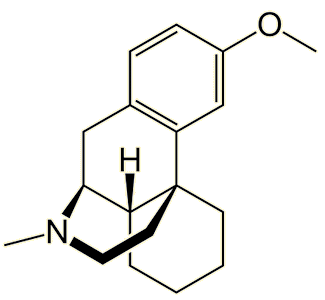 |
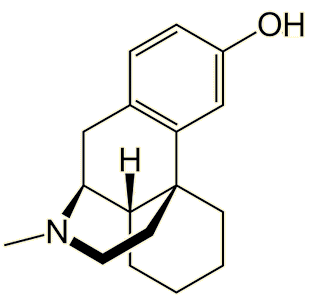 |
| Dextromethorphan (DXM) |
Dextrorphan (DXO) |
Well, at least it works!
To some extent…. Although there is some evidence that DXM does suppress coughs in adults in some cases, the jury is most definitely not decided as to whether it is a general treatment. Indeed, experiments show that it doesn’t work with children, and is ineffective against pneumonia, bronchitis or the common cold (despite it being sold as a cold medicine!).
But can it treat anything else?
Yes, there’s a rather bizarre ailment called Pseudobulbar affect (PBA), also called ‘emotional incontinence’, which causes uncontrollable laughing and/or crying. In the 2019 film Joker, Arthur Fleck (played by Joaquin Phoenix) displays signs of PBA. Indeed, the actor said he used the symptoms of this ailment to invent his character’s signature insane laugh. The first (2010) FDA-approved drug for the treatment of PBA, under the brand name Nuedexta, is a mixture of DXM and quinidine; the quinidine is used to slow down the breakdown of the DXM from 4h to over 13h, ensuring its concentration in the bloodstream remains high and allowing it time to interact with the brain receptors and suppress the impulse to laugh or cry.
|
 |
So it acts on the brain in other ways, too?
The chemical structure of DXM is quite similar to that of morphine (MOTM May 2004), and so it isn’t surprising that it can affect the brain in a number of different ways depending on the concentration. Indeed, at high doses DXM and its major metabolite, DXO, act as an hallucinogen. As well as the cough receptors, they can block other brain receptors producing effects similar to those from ketamine, nitrous oxide (MOTM June 1999), and phencyclidine.
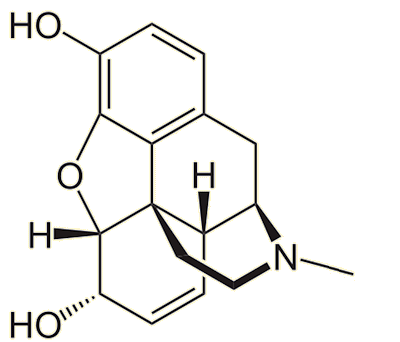 |
| Morphine |
So was it ever used as a recreational drug?
Indeed it was, and still is. Ironically, DXM was originally developed as an alternative cough medicine to codeine, which was notoriously addictive. Just as diacetylmorphine (a.k.a. heroin, MOTM March 2023) was developed as an alternative painkiller to the addictive morphine. And we know how well that worked out...
At first, this strategy worked well – and during the 1960s and 70s DXM became available over-the-counter as the brand name Romilar. But word got out onto the street that high doses of Romilar would give you hallucinations and a range of unusual psychological effects, and so people started using it recreationally... Indeed, people started having 'Dextro weekends’, when a group of people would get together in a party house and deliberately take overdoses of DXM together.
What effects does it have?
When taken at these very high doses, DXM produces visual distortions and excitement, along with feelings of dissociation, distorted bodily perception and a loss of the sense of time. It can also produce feelings of euphoria, particularly in response to music. In 1973, due to the huge burst in sales resulting from the discovery of this misuse, Romilar was taken off the shelves in the US and replaced a few years later with new DXM-containing products (such as Robitussin, Vicks-44, and Dextrotussion) with a deliberately unpleasant taste to discourage abuse. These bad tastes were removed a few years later, probably because they drastically reduced the sale of these medicines for their intended use.
|
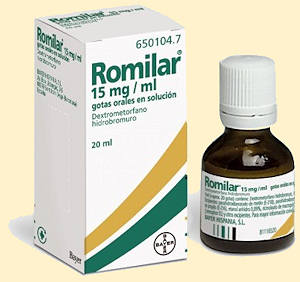 |
It is still used as a recreational drug nowadays. Illicit use of DXM is referred to on the street as “Robo- tripping” (derived from Robitussin) or "Triple Cs", from Coricidin whose tablets are printed with "CC+C" (Coricidin, Cough and Cold).
Is it additive?
Yes, if the user uses high doses over a long period of time. The normal dose for cough relief is 5 to 15 mg. It is estimated that the lethal dose is between 50 and 500 mg/kg, which equates to >3000 mg for a typical 60kg adult, i.e. around 200 times the normal dose! But the amounts taken by some recreational users to get their highs are only about three times lower than this lethal limit, so it is quite easy to accidentally overdose. Luckily, being an opioid, DXM overdose can be treated with naloxone, (see MOTM for November 2018). But health problems associated with long-term use can be severe: agitation, delusions, mood changes, depression, mania, memory loss, and liver damage.
I heard about 'NyQuil Chicken'...?
Yes, this is quite a bizarre story. In 2017, a video of someone preparing "NyQuil chicken" (a.k.a. “sleepy chicken”) became popular on social media. In the video, the chicken was boiled in cough syrup to 'help with cold symptoms'(!). Unsurprisingly, the U.S. FDA immediately issued a warning against cooking foods in cough syrup! Not only can the properties of cough syrup change when it is heated, making it potentially deadly, it can also vaporise, leading to problems if you breathe it in. Although it received attention from the news media, some people questioned if making and eating 'NyQuil chicken' actually existed as a widespread trend and that maybe this publicity was creating a ‘mountain out of a molehill’.
Why isn’t DXM banned?
Many countries and US States prohibit the sales of DXM medicines to children, and many retailers in the US have moved DXM-containing products behind the counter so that customers must ask a pharmacist to receive them. But cough medicines containing DXM are currently legal to purchase from pharmacies in most countries in the world, with a few exceptions, such as France, Russia, China and Indonesia, which require a doctor’s prescription. Following an epidemic of DXM misuse in Sweden in 1986, it became a prescription-only drug there, too.
|
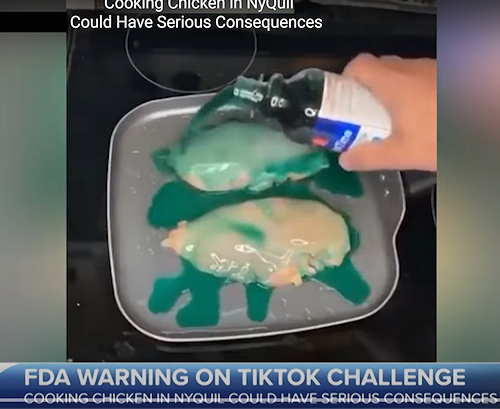
Frame from the infamous 'NyQuil chicken' video. |
Because of its benefit in cough medicines and its (relatively) low level of recreational abuse compared to many other opiate drugs, DXM was excluded from the 1970 Controlled Substances Act (CSA) and the 1961 Single Convention on Narcotic Drugs. It is still excluded from the list of U.S. Schedules of Controlled Substances. In 2010, one of the main reasons cited by the FDA’s advisory panel for not scheduling DXM is that this would create a huge amount of extra paperwork for pharmacists and clinicians – but they did warn that DXM could still be added to this list if recreational abuse cases rose significantly.
A 2015 report said that in the US almost 5% of high school seniors had abused over-the-counter cough medications in the past year, and DXM abuse currently results in around 6,000 visits to the emergency department each year. So perhaps the time has now come to rethink the regulations on this simple cough medicine.

Bibliography
- Wikipedia: Cold medicines; Dextromethorphan; Dextrorphan; Pseudobulbar affect; Recreational use of dextromethorphan; Psychedelic drug.
- K. Ackermann, DXM Addiction: Effects & Treatment (2023)
- M Hodgman-Korth, DXM Addiction: Effects, Symptoms, and Rehab Treatment
- J. Mutschler, et al., Dextromethorphan Withdrawal and Dependence Syndrome, Dtsch Arztebl Int. 107 (2010) 537–540.
- C.N. Stanciu, T.M. Penders, E. M. Rouse, Recreational use of dextromethorphan, 'Robotripping'-A brief review, Am. J. Addictions. 25 (2016) 374–377.
- S.M. Schneider, E.A. Michelson, C.D. Boucek, K. Ilkhanipour, Kaveh, Dextromethorphan poisoning reversed by naloxone, Am. J. Emergency Med. 9 (1991) 237–238.
- C.P. Taylor, S.F. Traynelis, J. Siffert, L.E. Pope, R.R. Matsumoto, Pharmacology of dextromethorphan: Relevance to dextromethorphan/quinidine (Nuedexta®) clinical use. Pharmacol. Therapeut. 164 (2016) 170–182.
- C. Nordqvist, Medical News Today, Cough Medications Should Stay As Over-The-Counter Drugs, FDA Panel Recommends, (2010).
- N. Olney, H. Rosen. AVP-923, a combination of dextromethorphan hydrobromide and quinidine sulfate for the treatment of pseudobulbar affect and neuropathic pain, IDrugs, 13 (2010) 254–265.
- D.M. Perrine, The Chemistry of Mind-Altering Drugs, Washington DC, ACS, 1996, especially pp. 71-74.
- 'NyQuil Chicken' video


 Back to Molecule of the Month page. [DOI:10.6084/m9.figshare.24943356]
Back to Molecule of the Month page. [DOI:10.6084/m9.figshare.24943356]
![]()
![]()
![]()
![]()







